Lubing your mechanical keyboard switches is a right of passage into the mechanical keyboard hobby. The question is, are you ready to bring to bring your keyboard to the next level? If so, it’s time to bust out the lube. Let’s get started.
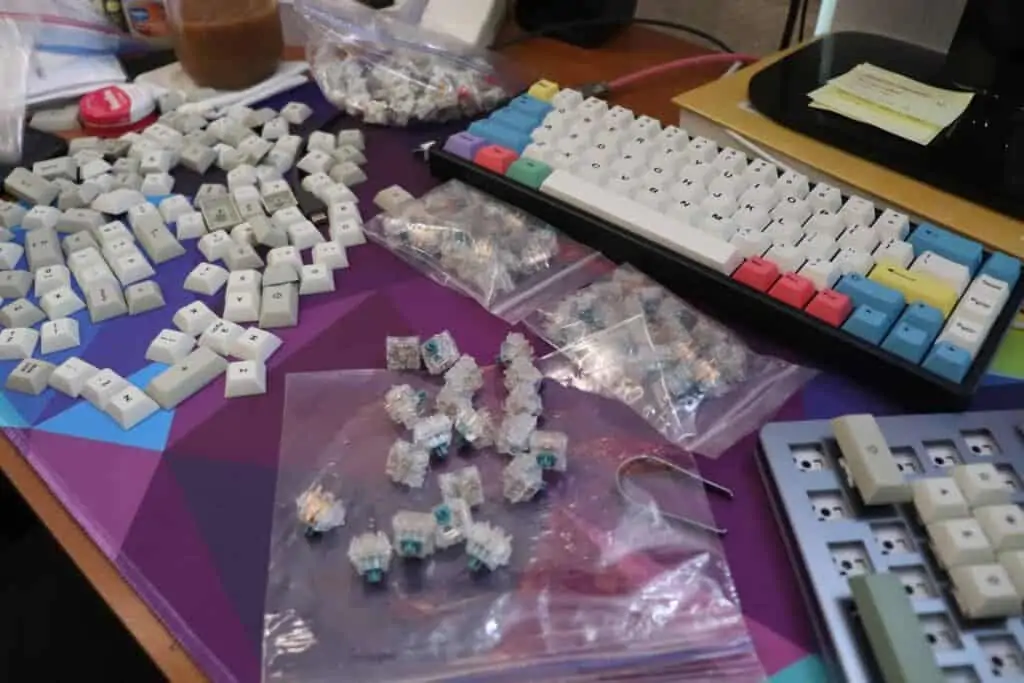
Why Lube Your Switches?
- Improved Acoustics
- Smoother Actuation
- Less Rattle
- Less Scratchiness
- Reduced Tactile Bump
- Fun & Therapeutic
Although it can be a time-intensive activity, lubing your switches improves your keyboard in so many different ways. If you want the best-sounding, smoothest feeling, and highest-quality board, lubing your switches is the way to go.
You can listen to a sound clip here of a keyboard before lubing and after lubing.
The Tools Required
You will need 6 tools to get the job done effectively. We’ll go over each one below.
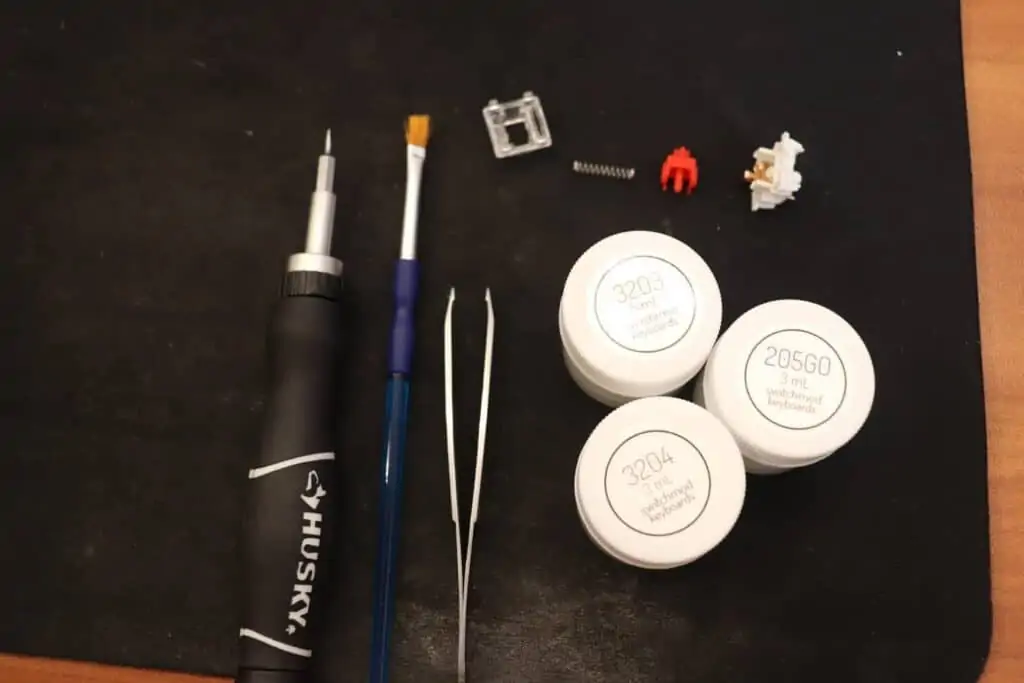
1. Lubricant
Picking out the best lube is hardest part. We have a full write up here on the best lube. If you don’t feel like reading another post, here is a quick crash course. There are three main switch types: tactile, linear, and clicky. The type of switch you have will determine which type of lube is required.
Best Lube for Tactile switches:
A lube that’s thinner or with a lower viscosity is best for tactile switches. We recommend the Krytox 105 if this is your first time. If you want to dampen the tactility more, Krytox 205G will work too.
Best Lube for Linear Switches:
A lube that’s thicker or with a higher viscosity is best for linear switches. We recommend the Krytox 205G if this is your first time.
Best Lube for Clicky switches:
In general, it’s recommended to not lube clicky switches. Lubing clicky switches can result in accidently converting your switch to a quieter tactile sound. Also, it may produce inconsistent sound between each switch. It’s best to not lube clicky switches.
2. Small Brush
You’ll need a small brush to apply the lube precisely to the switches. We recommend a #2 or 5mm sized paint brush (affiliate) to apply the lubricant.
3. Switch Opener or Flathead Screwdriver
To lube the switches, you’ll need to open them up first. The easiest way is getting a switch opener, but if you have a small flathead screwdriver laying around, that will work too.
4. Soldering Tools or Switch Puller
To remove and attach your switches to your keyboard, you’ll need to solder/de-solder them from the PCB. A hot-swappable keyboard is best for easy switch removal since there is no soldering required, all you will need is a switch puller.
5. Tweezers
Tweezers will really help with picking up the small components and keep you from getting grease on your fingers.
6. Clean Workspace Area
You’ll need a small workstation where you can lube the switches without making a mess. I usually clean off my desk and lay down some newspaper or paper towels to keep everything from getting greasy.
The Switch Components
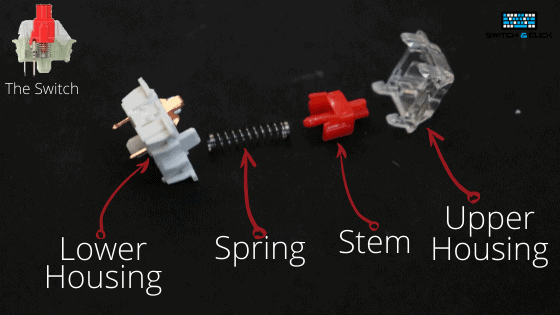
Each switch is composed of four different components: the stem, spring, bottom housing, and top housing. You can refer to the image above, so you have an idea what we mean when we throw these words around.
How to Lube Your Switches: The Steps
The 9 easy-to follow steps for lubing your mechanical keyboard switches.
1. Remove the Switches from your Keyboard
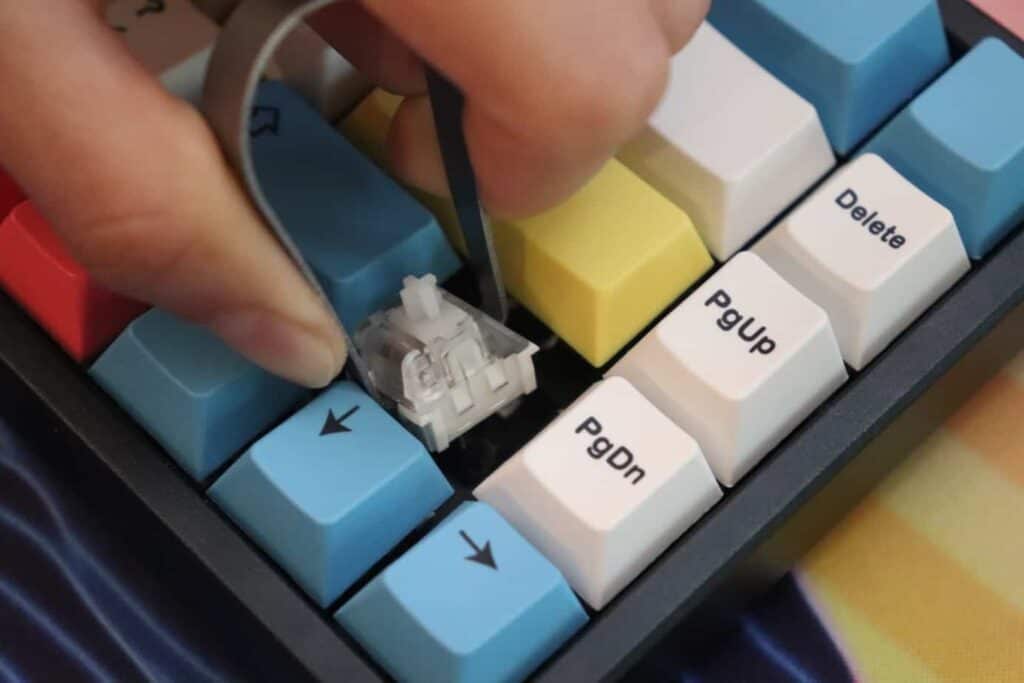
Unless you’ve ordered your switches in a separate bag, you’ll need to remove the switches from your keyboard. You’ll need to take off your keycaps and pull apart your keyboard and then de-solder the switches from the PCB. This can be quite difficult to do, so we linked a guide here. Always make sure to shut off your keyboard first.
If you have a hot-swappable keyboard, you simply take off the keycaps and remove the switches with a switch puller. This is the fastest way to remove switches, so a hot-swappable keyboard can save you a ton of time.
2. Pull Apart the Switch
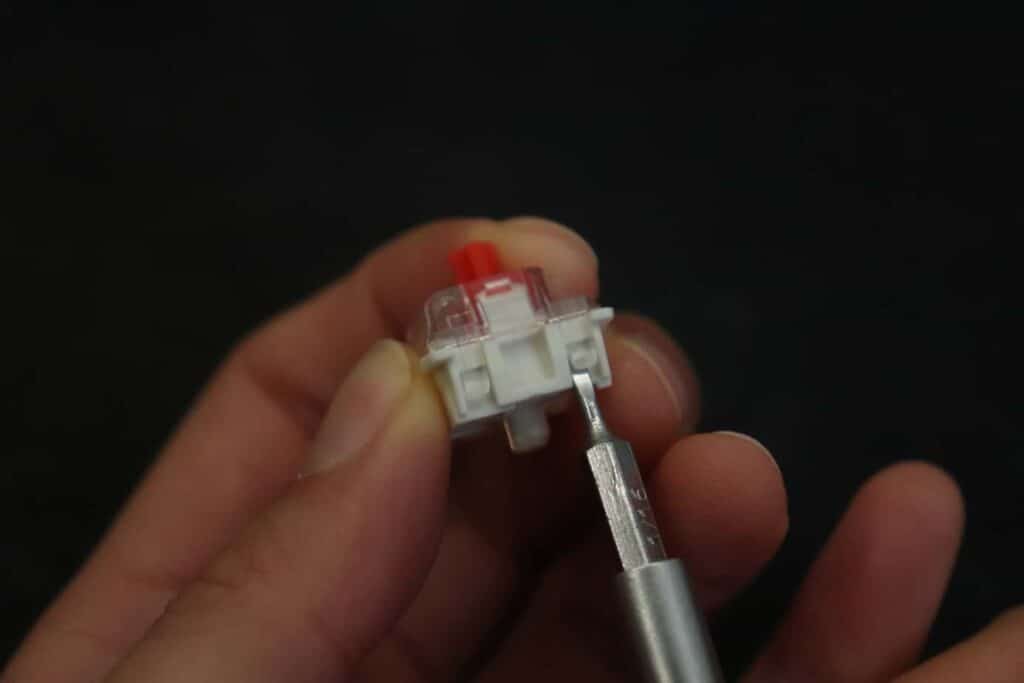
Now that the switch is removed from the keyboard, it’s time to pull the switch apart (we have a full guide here). The easiest way is with a switch puller, a specialized tool you can find online or order from a 3d print shop. We typically just use a small flathead screwdriver.
You want to work your way around the switch loosening the 4 clips that hold the upper housing and lower housing together. This can be a little difficult at first, but once you get a hang of it, it can be pretty quick. The toughest part is making sure the switch doesn’t snap back together once you’ve loosened one of the clips. It’s best to stick your fingernail between the upper and lower housing after you’ve loosened a clip.
3. Lube the Lower Housing
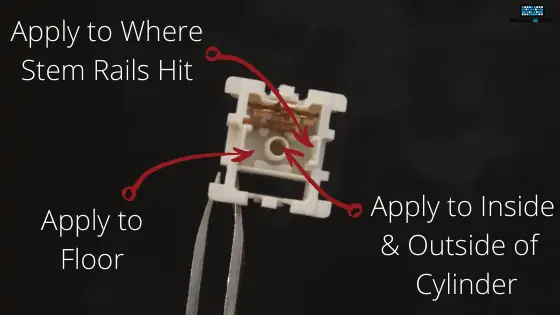
You will need to be a little careful lubing the lower housing. It’s best to avoid lubing the metal leaf if possible as it can damage your switch. We recommend lubing the inside floor of the switch, the part where the stem rails hit, and the inside/outside of the cylinder.
4. Lube the Spring
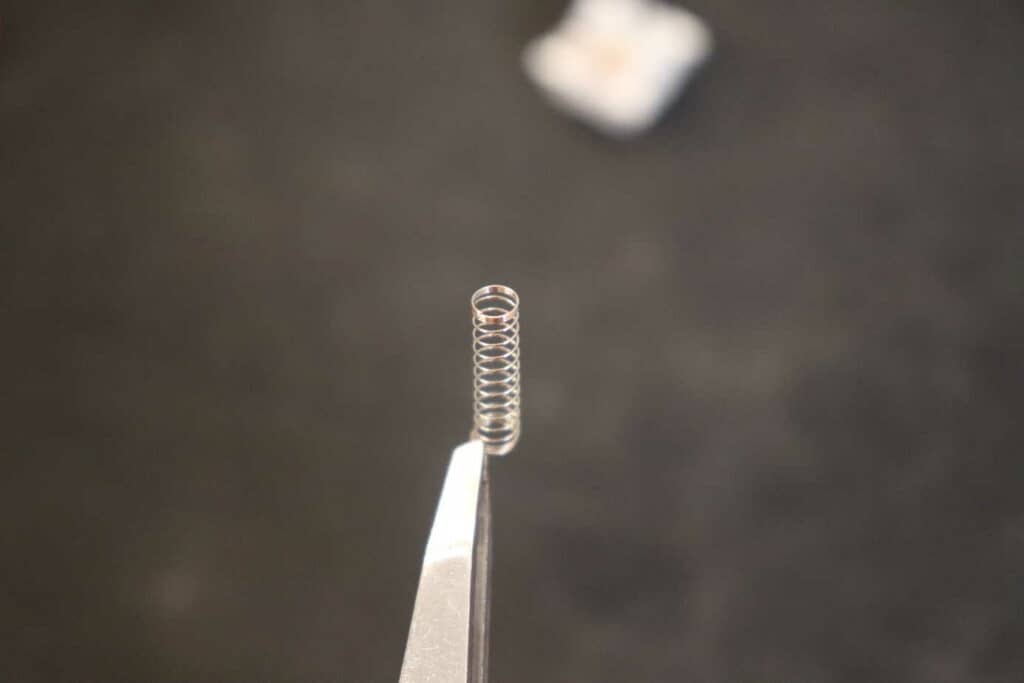
There are two main ways to lube the spring:
1) Apply lube to the entire spring with a brush. Best for your first time.
2) Take the springs out of all the switches and lube them in a single bag. Best for lubing big batches of springs at once.
Once you’re done lubing the spring, you can set it on the lower housing while you lube the stem and upper housing. This will help avoid making a mess and getting lube all over your workstation.
5. Lube the Stem
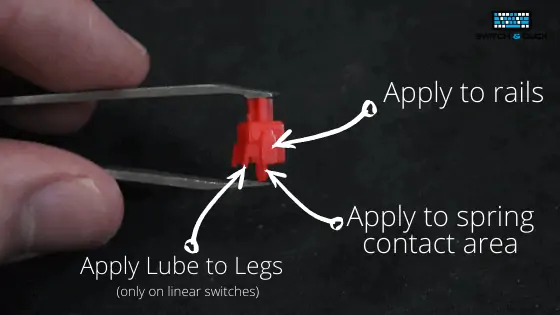
Lubing the stem is relatively straightforward, you just need to be careful with the legs. I would only recommend lubing the legs if you have a linear switch. You can lube the legs on a tactile switch, but it will reduce the tactile bump so it’s not recommended.
Regardless of the switch type, you should lube the rails and the cylindrical area where the spring contacts the stem.
If you want to go one step further, you can also apply lube to the other outside area of the stem, but it doesn’t improve the smoothness as much.
6. Lube the Upper Housing
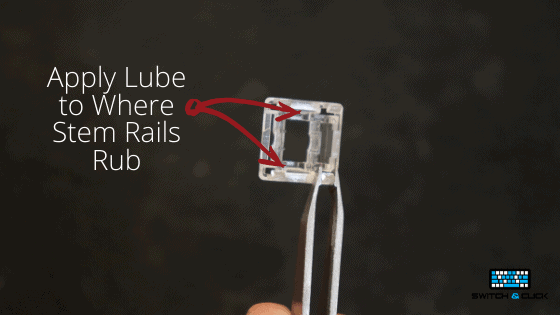
Lubing the upper housing is super easy. Simply lube the sections where the rails of the stem come in contact with the upper housing. You can ignore the rest of the upper housing.
7. Put Switch Back Together
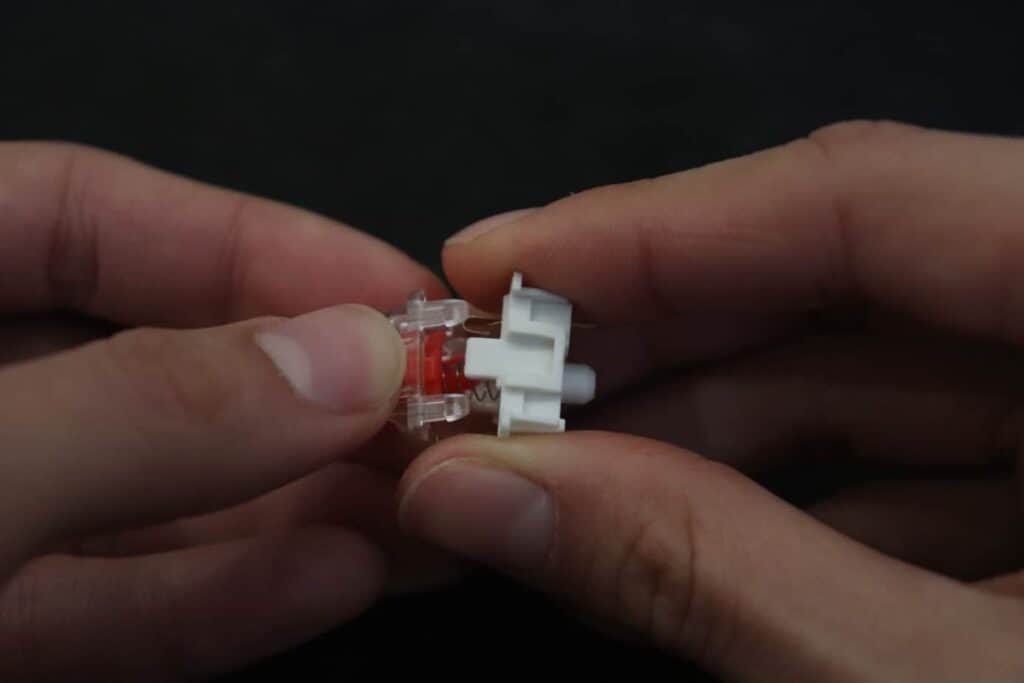
Congratulations, you’ve lubed everything! Now it’s time to put all of the components back together. The most important part is being extremely careful with the metal leaf. Simply line all of the components up again and snap the switch together.
Test to make sure the switch actuates properly and nothing feels wonky. If it does not work right, pull the switch apart again and reassemble.
8. Install Switches into Keyboard
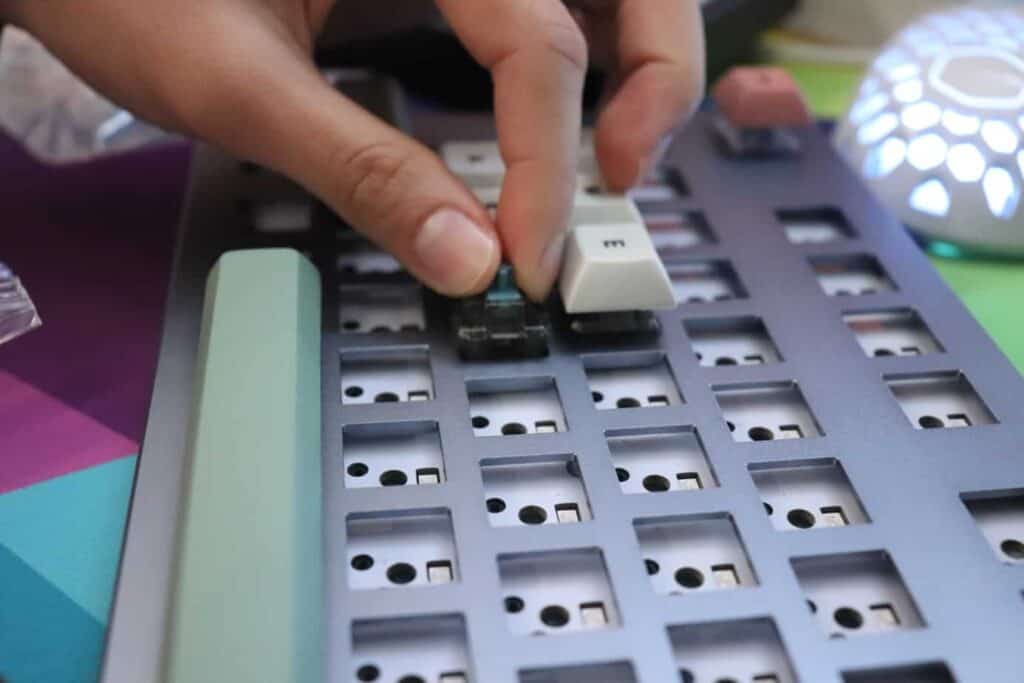
Now that the switches are lubed, it’s time to install them back into your keyboard. If you have a hot swap keyboard, simply press them into the sockets and you should be good to go. If not, you’ll need to resolder them to the PCB.
9. Plug in Keyboard and Test!

The final step is to plug the keyboard back in and test to make sure the switches work. We like to use this free online tester. Make sure to test the keyboard before putting the whole thing back together. It sucks to put the whole keyboard together and then have to go back and remove the keycaps and disassemble the whole case.
If a key doesn’t work, it’s most likely the switches weren’t soldered correctly or they didn’t enter the sockets right. If that’s not the issue, it’s possible the metal leaf inside the switches is damaged, in which case you’ll most likely need a new switch.
Should You Lube your Switches?

In general, if you have the time and the equipment, we recommend that everybody lubes their switches. There are certain switch types where it doesn’t make sense to lube, but for the most part, it’s highly recommended. The benefits are easily noticable, and once you go lubed, you never go back.
Switch Actuation Type
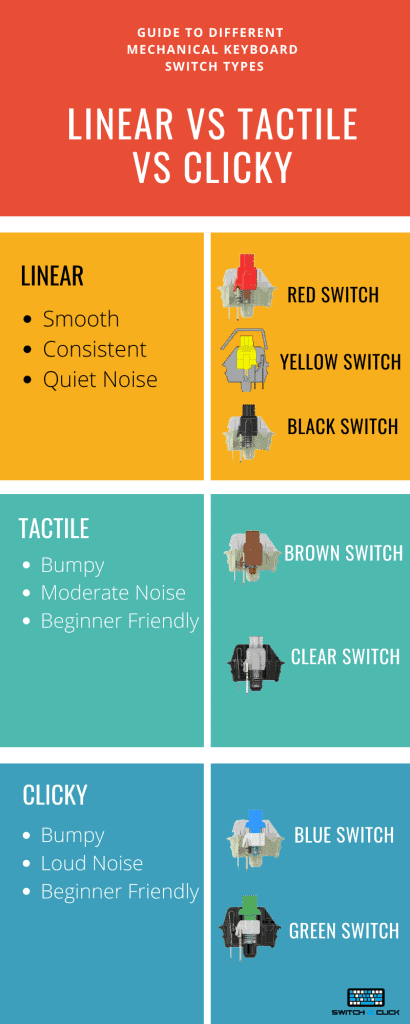
There are several factors to consider when deciding if you should lube your switches or not. The first thing to look at is the switch actuation type, clicky, linear, or tactile.
If you have a clicky switch, we don’t recommend lubing the switch. You may accidentally convert your clicky switch to tactile, and if you’re not super careful during the lubing process, you may accidently have uneven clicking and sound noises afterwards.
If you really want to lube your clicky switches, we recommend using a super thin lube and applying a thin coat to avoid ruining the switch. Lubing a clicky switch is definitely for the more advanced keyboard enthusiast.
Tactile switches can benefit from lubing, but we recommend using a thin lube for your first time. A thicker lube can work too, but it may remove a lot of the tactile bump. Less is more when it comes to lubing a tactile switch.
Linear switches, in my opinion, benefit 100% of the time from lubing. Since linear switches already actuate in smooth and consistent way, the lube removes a lot of the friction and scratchiness. The sound also improves since most the rattling sound will disappear.
Avoid Lubing Certain Switch Brands
Certain switch brands make it very difficult or impossible to take apart and lube. The main brand to avoid is Kailh BOX Switches. The switch housings are designed a different way so you can’t simply unclip them. In addition, the BOX switches will leak if you lube them, so it has a chance of damaging your keyboard. If you want lubed switches, stay away from Kailh BOX switches.
Sound & Feel Improvements
If your switches feel extra scratchy or sound rattly, lubing them will improve both the sound and feel instantly. There is a reason why lubing your switches is such a common practice in the mechanical keyboard community. If you want to improve your keyboard, lubing is one the highest impact mods you can do.
Can You Get Switches Pre-Lubed?
If you don’t want to go through the lengthy process of lubing the switches yourself, it is possible to order switches pre-lubed. You can find sellers of pre-lubed switches on /r/mechmarket, just be very careful not to get scammed by a seller as the mechmarket is basically the wild west. You can do research on the sellers to make sure they are legit before committing to a big purchase.
Can You Lube Switches Without Desoldering?
For many people, desoldering the switches is not feasible, you may not have the proper soldering equipment on hand or the space to do it. You can lube your keyboard switches without desoldering but it’s not as effective. We’ll link our full guide on how to lube without desoldering here.
The methods can be messy, so you’ll need lots of isopropyl alcohol on hand to clean up, and it’s not as effective as taking the switch apart and lubing that way. But it’s definitely recommended for those who don’t have soldering equipement on hand.
Conclusion
Lubing your switches is an awesome way to upgrade your keyboard and take it to the next level. We went over the equipment and steps we recommend to effectively lube your switches and get the much-improved sound and feel. If you have the ability and time to do it, we recommend everybody lube their switches, the improvement is very noticeable, and you will not want to go back to non-lubed switches.
Happy Typing!
